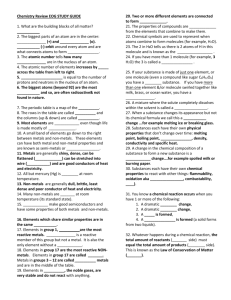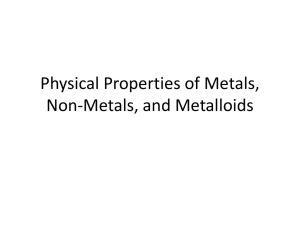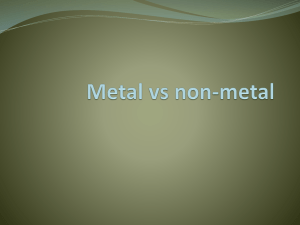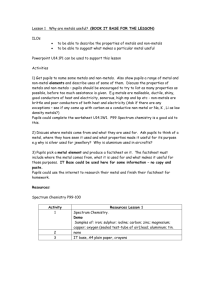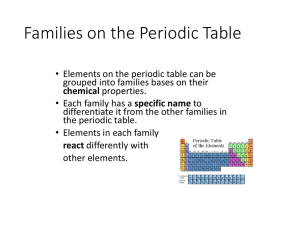Chapter 1 Fundamentals of chemistry Chapter Exercise 1. science
advertisement
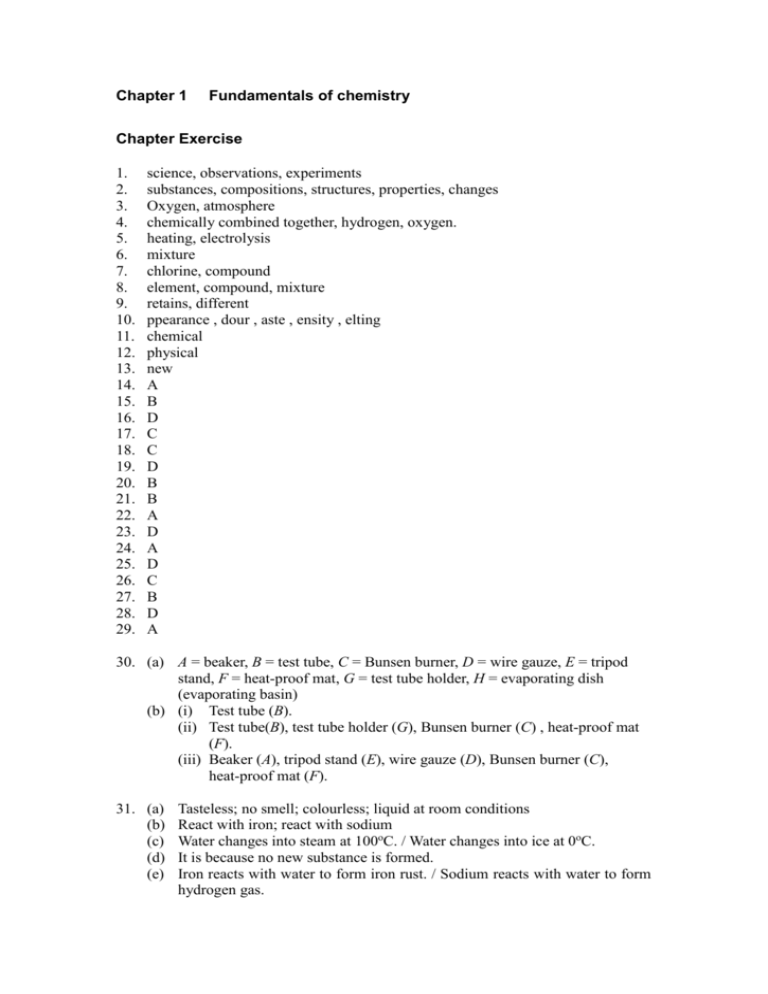
Chapter 1 Fundamentals of chemistry Chapter Exercise 1. 2. 3. 4. 5. 6. 7. 8. 9. 10. 11. 12. 13. 14. 15. 16. 17. 18. 19. 20. 21. 22. 23. 24. 25. 26. 27. 28. 29. science, observations, experiments substances, compositions, structures, properties, changes Oxygen, atmosphere chemically combined together, hydrogen, oxygen. heating, electrolysis mixture chlorine, compound element, compound, mixture retains, different ppearance , dour , aste , ensity , elting chemical physical new A B D C C D B B A D A D C B D A 30. (a) A = beaker, B = test tube, C = Bunsen burner, D = wire gauze, E = tripod stand, F = heat-proof mat, G = test tube holder, H = evaporating dish (evaporating basin) (b) (i) Test tube (B). (ii) Test tube(B), test tube holder (G), Bunsen burner (C) , heat-proof mat (F). (iii) Beaker (A), tripod stand (E), wire gauze (D), Bunsen burner (C), heat-proof mat (F). 31. (a) (b) (c) (d) (e) Tasteless; no smell; colourless; liquid at room conditions React with iron; react with sodium Water changes into steam at 100oC. / Water changes into ice at 0oC. It is because no new substance is formed. Iron reacts with water to form iron rust. / Sodium reacts with water to form hydrogen gas. (f) New substance (e.g. rust or hydrogen gas) is formed. 32. (a) Chlorine, hydrogen, iron, mercury , oxygen, sodium and sulphur (b) An element is a pure substance that cannot be broken down into anything simpler by chemical methods. (c) Ammonia, sodium chloride and water (d) A compound is a pure substance made up of two or more elements chemically combined together (e) A mixture consists of two or more pure substances (elements or compounds) which have not chemically combined together. (f) Sodium chloride solution is a mixture (because a solution is a homogeneous mixture). 33. (a) No. Both oxygen and hydrogen are gases at room conditions while glucose is a solid at room conditions. Carbon is black in colour while glucose is white. (b) Glucose solution is a mixture. It is because there is no chemical reaction taking place between glucose and water. (c) Glucose + oxygen carbon dioxide + water 34. Compounds and mixtures are different in a number of ways. These include: (1) Compounds have fixed chemical composition while mixtures have variable chemical composition. Examples: water and air (2) During the formation of compounds, a chemical change occurs. New substances are always formed. On the other hand, a mixture is obtained when different substances are physically mixed. There is no chemical change. No new substance is formed and the change is seldom accompanied by energy changes. Examples: formation of water from hydrogen and oxygen, mixing of sand and sugar (3) Properties of a compound are very different from that of its constituent elements. For example, water is colourless liquid while hydrogen and oxygen are colourless gases. On the other hand, each constituent substance retains its own properties in mixtures. For example, nitrogen and oxygen are both colourless gases no matter whether they are isolated or present together in the air. (4) Separation of the constituents of a compound requires a chemical process. For example, breaking water down into the elements hydrogen and oxygen requires a chemical process called electrolysis. On the other hand, separation of a mixture requires a physical process only. For example, separation of iron powder from a mixture just requires the use of a magnet. 35. PHYSICAL PROPERTIES of a substance are those properties that can be determined without the substance changing into another substance. Examples of physical properties of a substance include colour, odour (smell) and physical state. For example water is a colourless, odourless liquid under room conditions. CHEMICAL PROPERTIES of a substance are the chemical reactions of the substance, and the respective conditions under which each reaction takes place. Examples of chemical properties of a substance include how fast and vigorous it reacts (i.e., its reactivity) with another substance, the condition(s) needed for it to react with other substances and what products can be produced when it reacts with other substances. For example, hydrogen reacts vigorously with oxygen (or air) only when lit with a burning splint to form water. Chapter 2 The atmosphere Class Practice A2.1 (a) People in ancient times had little scientific knowledge. In fact, any visible portion of the Earth appeared more or less flat to the eyes. (b) Satellite photos clearly show that the Earth is roughly spherical. (Other answers may be given.) A2.2 atmosphere crust mantle inner core outer core A2.3 1. (a) No. (7 planets have an atmosphere.) (b) Yes. 2. There is no air on the Moon. A2.4 Elements nitrogen oxygen helium neon argon krypton xenon Compounds carbon dioxide water vapour A2.5 (a) Helium Neon Nitrogen Argon Oxygen Krypton Xenon Carbon dioxide 269 246 196 186 183 153 109 78 (b) Neon and helium. Chapter 2 The atmosphere Chapter Exercise 1. 2. 3. 4. 5. 6. 7. 8. 9. 10. 11. 12. 13. crust, mantle , core, atmosphere atmosphere nitrogen, oxygen fractional distillation liquefied supporter glowing A A B B B D 14. (a) Nitrogen (b) Carbon dioxide and water vapour (c) Oxygen, argon, neon, helium, krypton, xenon (any two) 15. (a) The volumes of the three gases obtained i.e. argon, nitrogen and oxygen are 930 litres, 78,000 litres and 21,000 litres respectively. (b) Fractional distillation (c) No. Oxygen is the most reactive gas in air, whereas nitrogen is unreactive, which serves the good purpose of ‘diluting’ oxygen in air. If there were more oxygen in air, metals would be oxidized and corroded faster. Things would also burn easier, so there would be a greater hazard of fire. 16. (a) Fractional distillation of liquid air (b) Oxidizing (c) Physical property: colourless, odourless Chemical property: it supports combustion (d) Put a glowing splint into a test tube containing the gas to be tested. If the gas is oxygen, the splint relights. 17. (a) (b) (c) (d) Nitrogen and oxygen Oxygen copper + oxygen copper(II) oxide 50 cm3 33 cm3 = 17 cm3 17 cm 3 (e) 100% = 34% 50 cm 3 (f) 21% (g) The percentage of oxygen in dissolved air (34 %) is much greater than that in the atmosphere (21 %) because oxygen is more soluble in water than nitrogen. 18. Fractional distillation of liquid air is used to separate nitrogen and oxygen from air. The air is first liquefied by repeated cooling and compression. Then the liquid air is warmed up bit by bit very slowly. Different gases in air boil at different temperatures, so they can be collected one by one. The one boiling off first is nitrogen (boiling point 196 C). The second one to be collected is argon(boiling point 186 C) /noble gas. Then oxygen gas (boiling point 183 C) is collected. Chapter 5 Atomic structure Class Practice A5.1 They are the only two liquid elements. A5.2 1. (a) Only an element can be classified as a metal or non-metal. Water is not an element. (b) Non-metal. (c) Metal. 2. (a) Mercury. All are metals. Mercury is a liquid, while the others are solids at room conditions. (b) Sulphur. Sulphur is a non-metal, while the others are metals. (c) Iodine. All are non-metals. Iodine is a solid, while the others are gases at room conditions. (d) Graphite. All are non-metals. Graphite conducts electricity, while the others are non-conductors of electricity. A5.3 (a) (i) (ii) (iii) (b) (i) (ii) (iii) (c) (i) (ii) (iii) Mg Ag Na Ar, He Ne fluorine bromine mercury A5.4 (a) 118 (b) Br (c) N (d) The element copper or a copper atom. A5.5 (a) The commonest type of hydrogen atom. (b) 91 electrons. Number of neutrons cannot be predicted. (c) It is not an atom. The numbers of protons and electrons are not equal. A5.6 A magnesium atom would be changed to a chlorine atom. A5.7 1. (a) silver (b) silver (c) silver 2. (a) Aluminium (b) 27 Al 13 (c) (i) 13 (ii) 13 (iii) 27 13 = 14 A5.8 (a) 3 (b) 16 O 8 (16O, or oxygen-16) A5.9 (a) 37 (b) 35 (c) 4 (d) 238 (e) We cannot tell from the given data. (The mass number is not given.) A5.10 (a) Relative atomic mass of sodium = mass number of the only type of sodium atom = 23 (b) Relative atomic mass of neon 20 90 22 10 = = 20.2 100 A5.11 (a) (b) (c) (d) A5.12 (a) 17 (b) (i) (ii) 2,8,7 Chapter 5 Atomic structure Chapter Exercise 1. 2. 3. 4. 5. 6. 7. 8. 9. 10. 11. 12. 13. 14. 15. 16. 17. 18. 19. 20. 21. 22. 23. 24. 25. physical bromine, mercury metals, non-metals metals, non-metals, graphite ymbol smallest part element atoms nucleus, neutrons, nucleus, electrons positively, negatively, neutral protons mass number same, different carbon-12 weighted average, relative isotopic shells electronic arrangement (electronic configuration) B D D B C D C D 26. (a) True. This is because there is no gaseous metal or semi-metal at room conditions. (b) False. This is because mercury is a liquid metal at room conditions. (c) False. This is because carbon (graphite) is a non-metal which can conduct electricity. / This is because semi-metals cannot conduct electricity by themselves. (d) False. This is because some metals (e.g. sodium) are soft. (e) True. This is because metals are silvery white, golden or brown in colour. No metal is red in colour. 27. (a) The mass number of an atom is the sum of the number of protons and neutrons in the atom. (b) The atomic number of an atom is the number of protons in the atom. (c) Isotopes are different atoms of the same element, with the same number of protons (and electrons) but different numbers of neutrons. (d) (e) Atom Number of Number of Electronic protons neutrons configuration 10 B 5 5 2, 3 5 11 B 5 6 2, 3 5 10 20 11 80 10.8 100 28. (a) Q and R (b) Carbon (c) Carbon-13 and carbon-14 (d) 135 P, 136 Q, 146 R, 147 S 29. (a) Atom (a) (b) (c) 35 Cl 17O 40 Ar Atomic no. Mass no. 17 8 18 35 17 40 Number of protons neutrons 17 18 9 8 22 18 Electronic electrons arrangement 17 2, 8, 7 8 2, 6 18 2, 8, 8 (b) (c) Neon (d) Argon is very unreactive. 30. Elements can be classified according to their physical states. For example, at room temperature, hydrogen and oxygen are gases; bromine and mercury are liquids; carbon and iodine are solids. Elements can also be classified into metals and non-metals. A few elements have properties in between those of metals and non-metals. They are classified as semi-metals. Examples of metals include sodium and mercury; examples of non-metals include bromine and hydrogen; examples of semi-metals include boron and silicon. Chapter 6 The Periodic Table Class Practice A6.1 (a) Period 7, Group II; alkaline earth metals. (b) Radium. (c) Yes. Radium is a metal (all metals conduct electricity). A6.2 Element X: Metal Element Y: Non-metal Element Z: We cannot tell from the given data as elements in Group IV can be a metal, non-metal or semi-metal. A6.3 (a) 2, 8, 8, 2. (b) Yes, it is a metal. (c) (ii). A6.4 (a) Yes. By knowing the chemical properties of familiar elements in the same group and the group trend, predictions about the unfamiliar element can be made. (b) Astatine: D; strontium: A Chapter 6 The Periodic Table Chapter Exercise 1. 2. 3. 4. 5. 6. 7. 8. 9. 10. 11. 12. 13. 14. 15. 16. 17. electrons, outermost ascending, atomic numbers period, group, eight, period number, outermost metals, semi-metals, non-metals chemical 1, 1, increases 7, halogens, decreases 8, noble gases B B D C C C C D 18. Element Electronic arrangement A 2, 6 B 2, 8, 2 C 2, 8, 8, 1 D 2, 8 E 2, 8, 18, 3 F 2, 8, 18, 18, 7 Atomic number 8 12 19 10 31 53 Period number 2 3 4 2 4 5 Group number VI II I 0/VIII III VII 19. (a) (b) (c) (d) 2 They all have two electrons in the outermost shell. Increase down the Group. (i) Beryllium reacts very slowly with water. (ii) Barium reacts vigorously with water. (e) Barium is more reactive than calcium. It should be stored under paraffin. 20. (a) (b) (c) (d) (e) (f) (g) (h) (i) Magnesium, silicon, chlorine. They are in Period 3. Lithium, rubidium, caesium. They are in Group I. Iron, copper Caesium Fluorine Silicon Helium Helium, fluorine, chlorine Fluorine, chlorine 21. (a) (b) (c) (d) (e) 22. Group II Alkaline earth metals Strontium has 2 outermost shell electrons. Strontium is a silvery white solid at room conditions. Strontium reacts with cold water more readily than calcium does and colourless gas bubbles are given off. This is because the reactivity of Group II elements will increase down the group. In the modern Periodic Table, elements are arranged in ascending order of atomic number. The elements are arranged in periods and groups of the Periodic Table. A horizontal row of elements is called a period while a vertical column of elements is called group. Period number = number of occupied electron shells Group number = number of electrons in outermost shell Elements within the same group of the Periodic Table have similar chemical properties. Across a period, the elements change from metals through semi-metals to non-metals. Some of the groups have special names. Group I elements are named as alkali metals; Group II elements are named as alkaline earth metals; Group VII elements are named as halogens; Group 0 elements are named as noble gases. The elements in between Group II and Group III are called the transition elements.
